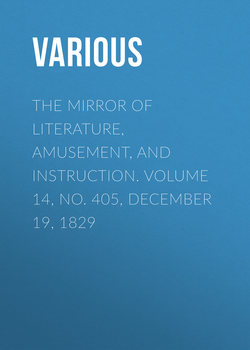Читать книгу The Mirror of Literature, Amusement, and Instruction. Volume 14, No. 405, December 19, 1829 - Various - Страница 1
NEW BUILDINGS, INNER TEMPLE
Оглавление"The Temple," as our readers may be aware, is an immense range of buildings, stretching from Fleet-street to the River Thames, north and south; and from Lombard-street, Whitefriars, to Essex-street, in the Strand, east and west. It takes its name from having been the principal establishment, in England, of the Knights Templars; and here, in the thirteenth century they entertained King Henry III., the Pope's Nuncio, foreign ambassadors, and other great personages. The king's treasure was accustomed to be kept in the part now called the Middle Temple; and from the chief officer, who, as master of the Temple, was summoned to Parliament in the 47th of Henry III., the chief minister of the Temple Church is still called Master of the Temple. After the suppression of this once celebrated order,1 the professors of the common law purchased the buildings, and they were then first converted into Inns of Court, called the Inner and Middle Temple, from their former relation to Essex House, which as a part of the buildings, and from its situation outside the division of the city from the suburbs formed by Temple Bar, was called the Outer Temple.
The principal part, or what we might almost call the nucleus of the Inner Temple, is the Hall and Chapel, which were substantially repaired in the year 1819. Thence a range of unsightly brick buildings extended along a broad paved terrace, to the south, descending to the Garden, or bank of the Thames. These buildings have lately been removed, and the above splendid range erected on their site, from the designs of Robert Smirke, Esq., R.A. They are in the Tudor, or to speak familiarly, the good Old English school of architecture, and combine all the picturesque beauty of ancient style with the comfort and elegance of modern art in the adaptation of the interior. Our succinct sketch of the origin of the Temple will sufficiently illustrate the appropriateness of Mr. Smirke's choice. Over the principal windows, on escutcheons, are the Pegasus, the Temple arms, and the respective arms of Henry III. and George IV. At the end immediately adjoining the Chapel, is a Latin inscription with the date of the repairs, 1819, and at the eastern extremity of the present building is another inscription with the date of 1828, in which the last improvements were commenced. Viewed from the Terrace, the whole range has a handsome and substantial appearance, sufficiently decorated, yet not overloaded with ornament. From another point, Whitefriars Gate, the end of the building, with its fine oriel window, is seen to considerable advantage. Against the old brick house on this spot was a sun-dial, with the quaint conceit, "Begone about your business." The cast-iron railing of the area appears to us extremely elegant and appropriate.
The interior is not yet completed, but, by the courtesy of the architect we have obtained a view of its unfinished state. The principal apartments are the Parliament Chamber on the first, and the Library on the second floor. The Chamber adjoins the Hall, and is intended for a withdrawing-room, whither the Templars of our times, after dining in the Hall, may repair to exercise the argumentum ad Bacculinum in term time. The dimensions of this room are in height about 13 feet; length 37 feet; and width about 27 feet. Above is the Library, which is indeed a magnificent room. The height is about 20 feet; length 39 feet; and width in the centre about 37 feet. The fine window, of which we spoke in our description of the exterior, is not yet glazed; its height is 17 feet, and width 14 feet; and the mullions, &c. are very rich. The remainder of the buildings will be occupied by ante-rooms, and chambers for barristers. The whole will be fire-proof, the floors being divided by plate-iron archings upon cast-iron bearings.
The Inner Temple Hall is a fine room, though comparatively small. It is ornamented with the portraits of William III. and Mary, and the Judges Coke and Littleton; it is also embellished with a picture of Pegasus, painted by Sir James Thornhill. The Middle Temple has likewise a Hall, which is spacious and fine: here were given many of the feasts of old times, before mentioned. It contains a fine picture of Charles I. on horseback, by Vandyke, and portraits of Charles II. Queen Anne, George I. and George II.
There is a host of pleasing associations connected with the Temple, if we only instance the seasonable doings there at Christmas—as breakfasting in the hall "with brawn, mustard, and malmsey;" and at dinner, "a fair and large Bore's head upon a silver platter with minstralsaye."
1
In the Temple Church, lie the remains, marked out by their effigies, of numbers of the Templars. For a Description and Engraving of the Church, see MIRROR, No. 274.
